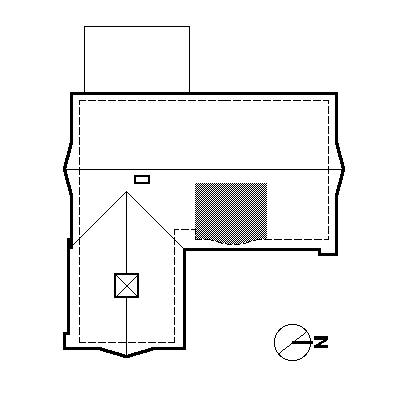 (Continued from part 2.) (Continued from part 2.)Finishing a bow or bay window with proper trimboards always require careful planning, detailing and precise cutting of all the pieces because there are a lot of angles. In fact, computer-aided drafting was essential. |
 For visual balance, I created a heavy bullnose wrap-around sill to add some "heft." It had to have good shadow lines. The profile took no less than three pieces. With so many odd-angled segments to cut, anything more elaborate was not practical. The half-round piece is a 2x redwood moulded with two passes on the router using a 3/4"-radius roundover bit. The skirt had to be tall enough for appearance as well as to create the proper drip to keep rain water out. The transition at the wall, to the side trim, was especially tricky. I had to use the Dremel tool there.
For visual balance, I created a heavy bullnose wrap-around sill to add some "heft." It had to have good shadow lines. The profile took no less than three pieces. With so many odd-angled segments to cut, anything more elaborate was not practical. The half-round piece is a 2x redwood moulded with two passes on the router using a 3/4"-radius roundover bit. The skirt had to be tall enough for appearance as well as to create the proper drip to keep rain water out. The transition at the wall, to the side trim, was especially tricky. I had to use the Dremel tool there.Luckily I had a large overhang. Framing up to the tail rafters was a lot easier than creating a new roof over the window. Weather protection is always a critical issue with protruding windows. I think mine turned out okay.

Caveats
Pella makes a good product. But they are a direct distributor (except for their limited Proline series, available at Lowes). This means you have to deal with Pella salesmen. For their San Francisco east bay team, I tend to hesitate in recommending Pella. After giving me my fantastic deal, they felt they had to skimp on normal service. Delivery of the windows came five weeks after their promised date (initial order was made in May!). Then the missing cable connection kit was nearly impossible to get. I had to twist some more arms. A factory dent on an interior wood surface became my own fix after waiting two months for nothing. Their only saving grace was a warranty-replacement of two glazing panels after six months with no questions asked. So beware. Or just pay full price.
Price comparisons
A vinyl bow window the same size would cost about $2,000 (Milgard). Installation costs of a bow window like this would be about $3,500, with unknown detail designs. So I estimate the "full retail" cost of the installed Pella bow to be about $6,800. I like to think I saved a ton of money, but I realize this is still a splurge.
 (Continued from
(Continued from 

 A Prairie style lamp was
A Prairie style lamp was 



 Eleven 1-gallons shrubs from Home Depot. Emerald Gaiety Euonymus, "a dense, erect branching, evergreen shrub, can be used as a colorful border or foreground planting, rich green, rounded leaves have a pronounced white margin, part shade to shade, 3ft tall, low water once established, low maintenance."
Eleven 1-gallons shrubs from Home Depot. Emerald Gaiety Euonymus, "a dense, erect branching, evergreen shrub, can be used as a colorful border or foreground planting, rich green, rounded leaves have a pronounced white margin, part shade to shade, 3ft tall, low water once established, low maintenance." Digging through hardpan is never fun. Too bad I didn't think of renting a demolition hammer. Oh well. Instead, I hired a laborer to swing a pick axe. Poor guy. Hope he didn't break his back. He looked strong, though.
Digging through hardpan is never fun. Too bad I didn't think of renting a demolition hammer. Oh well. Instead, I hired a laborer to swing a pick axe. Poor guy. Hope he didn't break his back. He looked strong, though. The floor of the trench is practically waterproof, so to improve drainage I installed a perforated pipe — sometimes called a french drain. I sloped mine gradually, running it under the driveway as a solid pipe, then perforated again to a
The floor of the trench is practically waterproof, so to improve drainage I installed a perforated pipe — sometimes called a french drain. I sloped mine gradually, running it under the driveway as a solid pipe, then perforated again to a 


 The pump itself is a small one that I got second-hand from my brother. It has the usual float switch, inlet connection that fits a common garden hose, and a grounded AC (alternating current) plug. These units are designed to be submersed for a long time. For good measure, my outlet is GFCI (ground-faulted circuit interrupter). The hole in the sump pit for the electrical conduit should be installed as high as possible to keep water away from electrical connections.
The pump itself is a small one that I got second-hand from my brother. It has the usual float switch, inlet connection that fits a common garden hose, and a grounded AC (alternating current) plug. These units are designed to be submersed for a long time. For good measure, my outlet is GFCI (ground-faulted circuit interrupter). The hole in the sump pit for the electrical conduit should be installed as high as possible to keep water away from electrical connections.





